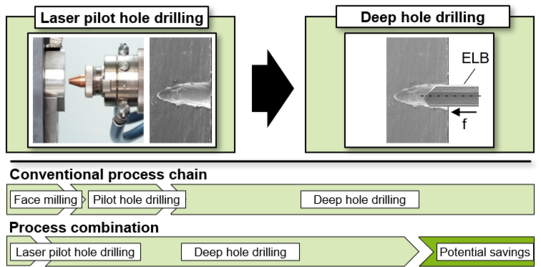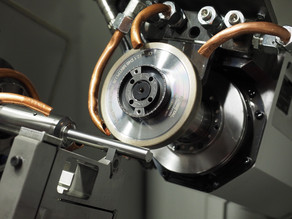Fundamental Investigations of Micro Single-Lip Deep Hole Drilling of Challenging Drilling Situations
The aim of this research project is to obtain the fundamentals for an innovative process combination, consisting of pilot-hole drilling by laser radiation and subsequent mechanical micro single-lip deep hole drilling. By combining the processes, the advantages of laser drilling, characterized by wearless machining and short primary production times, are merged with the high quality and increased aspect ratios achieved by mechanical single-lip deep hole drilling, thus significantly reducing production time. The central aspect of these investigations is the realization of the process combination for deep hole drilling with small diameters for unfavourable machining situations on inclined, curved and surface-hardened workpieces. Industrial fields of application are, for instance, the machining of strongly varying and complex-shaped implants in the medical industry, the production of lubrication holes in bearing rings and gear shafts in the automotive industry as well as the production of cooling channels in turbine blades in the aerospace industry.
As a first step, drilling tests to assess the material removal in single-pulse laser drilling processes are conducted on planar drilling surfaces. After the evaluation of suitable process parameters for laser pilot drilling, the implementation of the process combination for different workpiece surfaces is focused, taking into account the requirements on bore properties for the subsequent single-lip deep hole drilling process, such as the shape and quality of the laser pilot holes. The experimental work will be carried out on an existing special purpose machine, which is designed particularly for this application and enables the process combination of laser pilot-hole drilling and mechanical single-lip deep hole drilling in one clamping. The process combination is compared to the conventional process chain, consisting of the manufacturing steps face milling of a planar surface, pilot drilling with twist drills and single-lip deep-hole drilling, by means of comparative tests on a machining centre. The technological and economical evaluation considers the achieved tool life, chip formation, bore quality and process time.
Based on the fundamental investigations, the second step of the project objective is to extend the flexibility of the laser process, which has so far been limited by the single-pulse method, with regard to the achievable bore diameters by using the laser drilling method helix-drilling. The focus of the investigations lies on a reduction of the diameter deviations of the laser pilot drillings as well as an increase of the precision, which in contrast to the single pulse method is ensured by the statistical distribution of the material removal on a multiplicity of laser pulses. Furthermore, the focus point of the laser during helical drilling is to be adapted to the surface contour over the entire intersection of the pilot hole entrance by means of an appropriate CNC controlled positioning of the workpiece, thus significantly improving the roundness of the laser drill hole. With regard to the subsequent mechanical deep hole drilling process, the use of step drills is analyzed. The aim is to create a guide in the laser pilot hole by the first stage of the tool, so that subsequently the bore surface is drilled out with the second stage of the tool. This leads to an improvement of the generated surface quality, but requires a local heat treatment by the laser radiation for the surface hardened workpieces, so that an reduction of the tool wear can be realized due to the thermal softening of the surface and subsurface. In further investigations, the possibility of additively manufacturing components by selective laser melting already including pilot-holes for guidance of subsequent single-lip deep hole drilling is being analysed.





![[Translate to English:] [Translate to English:]](/storages/isf-mb/_processed_/a/1/csm_Wendel_Tiefbohrer_51a08eea1c.jpg)